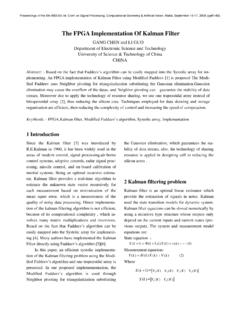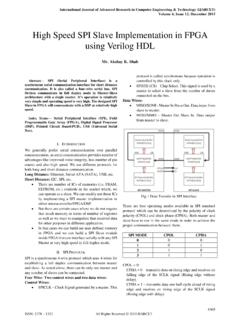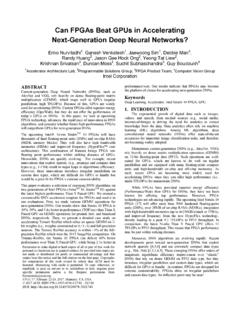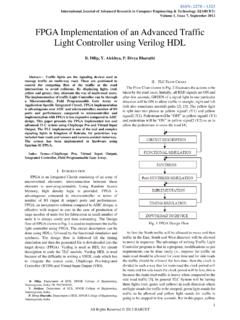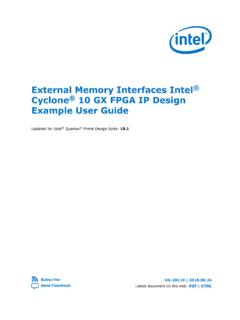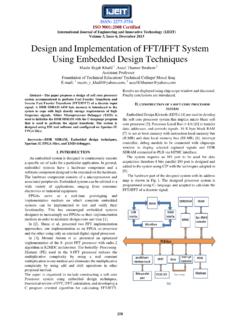Transcription of Virtex-6 Family Overview (DS150) - All Programmable
1 DS150 ( ) August 20, Specification1 2009 2015 xilinx , Inc. xilinx , the xilinx logo, Artix, ISE, Kintex, Spartan, Virtex, Zynq, and other designated brands included herein are trademarks of xilinx in the United States and other countries. PCI, PCIe, and PCI Express are trademarks of PCI-SIG and used under license. All other trademarks are the property of their respective DescriptionVirtex -6 fpgas are the Programmable silicon foundation for Targeted Design Platforms that deliver integrated software and hardware components to enable designers to focus on innovation as soon as their development cycle begins. Using the third-generation ASMBL (Advanced Silicon Modular Block) column-based architecture, the Virtex-6 Family contains multiple distinct sub-families.
2 This Overview covers the devices in the LXT, SXT, and HXT sub-families. Each sub- Family contains a different ratio of features to most efficiently address the needs of a wide variety of advanced logic designs. In addition to the high-performance logic fabric, Virtex-6 fpgas contain many built-in system-level blocks. These features allow logic designers to build the highest levels of performance and functionality into their FPGA-based systems. Built on a 40 nm state-of-the-art copper process technology, Virtex-6 fpgas are a Programmable alternative to custom ASIC technology. Virtex-6 fpgas offer the best solution for addressing the needs of high-performance logic designers, high-performance DSP designers, and high-performance embedded systems designers with unprecedented logic, DSP, connectivity, and soft microprocessor of Virtex-6 FPGA Features Three sub-families: Virtex-6 LXT fpgas : High-performance logic with advanced serial connectivity Virtex-6 SXT fpgas : Highest signal processing capability with advanced serial connectivity Virtex-6 HXT fpgas .
3 Highest bandwidth serial connectivity Compatibility across sub-families LXT and SXT devices are footprint compatible in the same package Advanced, high-performance FPGA Logic Real 6-input look-up table (LUT) technology Dual LUT5 (5-input LUT) option LUT/dual flip-flop pair for applications requiring rich register mix Improved routing efficiency 64-bit (or two 32-bit) distributed LUT RAM option per 6-input LUT SRL32/dual SRL16 with registered outputs option Powerful mixed-mode clock managers (MMCM) MMCM blocks provide zero-delay buffering, frequency synthesis, clock-phase shifting, input-jitter filtering, and phase-matched clock division 36-Kb block RAM/FIFOs Dual-port RAM blocks Programmable -Dual-port widths up to 36 bits-Simple dual-port widths up to 72 bits Enhanced Programmable FIFO logic Built-in optional error-correction circuitry Optionally use each block as two independent 18 Kb blocks High-performance parallel SelectIO technology to I/O operation Source-synchronous interfacing using ChipSync technology Digitally controlled impedance (DCI)
4 Active termination Flexible fine-grained I/O banking High-speed memory interface support with integrated write-leveling capability Advanced DSP48E1 slices 25 x 18, two's complement multiplier/accumulator Optional pipelining New optional pre-adder to assist filtering applications Optional bitwise logic functionality Dedicated cascade connections Flexible configuration options SPI and Parallel Flash interface Multi-bitstream support with dedicated fallback reconfiguration logic Automatic bus width detection System Monitor capability on all devices On-chip/off-chip thermal and supply voltage monitoring JTAG access to all monitored quantities Integrated interface blocks for PCI Express designs Compliant to the PCI Express Base Specification Gen1 ( Gb/s) and Gen2 (5 Gb/s) support with GTX transceivers Endpoint and Root Port capable x1, x2, x4, or x8 lane support per block GTX transceivers.
5 Up to Gb/s Data rates below 480 Mb/s supported by oversampling in FPGA logic. GTH transceivers: Gb/s to beyond 11 Gb/s Integrated 10/100/1000 Mb/s Ethernet MAC block Supports 1000 BASE-X PCS/PMA and SGMII using GTX transceivers Supports MII, GMII, and RGMII using SelectIO technology resources 2500Mb/s support available 40 nm copper CMOS process technology core voltage (-1, -2, -3 speed grades only) Lower-power core voltage option (-1L speed grade only) High signal-integrity flip-chip packaging available in standard or Pb-free package options11 Virtex-6 Family OverviewDS150 ( ) August 20, 2015 Product SpecificationVirtex-6 Family OverviewDS150 ( ) August 20, Specification2 Virtex-6 FPGA Feature SummaryTa b l e 1 : Virtex-6 FPGA Feature Summary by DeviceDeviceLogic CellsConfigurable Logic Blocks (CLBs)DSP48E1 Slices(2)Block RAM BlocksMMCMs(4)InterfaceBlocks forPCI Express(5)EthernetMACs(6)Maximum TransceiversTotalI/OBanks(7)MaxUser I/O(8)Slices(1)Max Distributed RAM (Kb)18 Kb(3)36 KbMax (Kb)
6 GTXGTHXC6 VLX75T74,49611,6401,0452883121565,616614 1209360XC6 VLX130T 128,00020,0001,7404805282649,50410242001 5600XC6 VLX195T 199,68031,2003,04064068834412,3841024200 15600XC6 VLX240T 241,15237,6803,65076883241614,9761224240 18720XC6 VLX365T 364,03256,8804,13057683241614,9761224240 18720XC6 VLX550T 549,88885,9206,2008641,26463222,75218243 60301200XC6 VLX760758,784 118,5608,2808641,44072025,92018000030120 0XC6 VSX315T 314,88049,2005,0901,3441,40870425,344122 424018720XC6 VSX475T 476,16074,4007,6402,0162,128 1,064 38,304182436021840XC6 VHX250T 251,90439,3603,0405761,00850418,14412444 808320XC6 VHX255T 253,44039,6003,0505761,03251618,57612222 42412480XC6 VHX380T 382,46459,7604,5708641,53676827,64818444 82418720XC6 VHX565T 566,78488,5606,3708641,82491232,83218444 82418720 Notes: Virtex-6 FPGA slice contains four LUTs and eight flip-flops, only some slices can use their LUTs as distributed RAM or DSP48E1 slice contains a 25 x 18 multiplier, an adder, and an RAMs are fundamentally 36 Kbits in size.
7 Each block can also be used as two independent 18 Kb CMT contains two mixed-mode clock managers (MMCM). to UG517, Virtex-6 FPGA Integrated Block for PCI Express User Guide for supported core pinouts by table lists individual Ethernet MACs per not include configuration Bank number does not include GTX or GTH Family OverviewDS150 ( ) August 20, Specification3 Virtex-6 FPGA Device-Package Combinations and Maximum I/OsVirtex-6 LXT and SXT FPGA package combinations with the maximum available I/Os per package are shown in Ta b l e 2. Virtex-6 HXT FPGA package combinations with the maximum available I/Os per package are shown in Ta b l e 3. Ta b l e 2 : Virtex-6 LXT and SXT FPGA Device-Package Combinations and Maximum Available I/OsPackageFF484 FFG484 FFV484FF784 FFG784 FFV784FF1156 FFG1156 FFV1156(1)FF1759 FFG1759 FFV1759(2)FF1760 FFG1760 Size (mm)23 x 2329 x 2935 x x x 8240 12360XC6 VLX130T 8240 1240020600XC6 VLX195T 1240020600XC6 VLX240T 124002060024720XC6 VLX365T2060024720XC6 VLX550T3684001200XC6 VLX76001200XC6 VSX315T2060024720XC6 VSX475T2060036840 Notes: package is available in the LX75T, LX130T, LX195T, and LX240T devices package is available in the LX240T device b l e 3.
8 Virtex-6 HXT FPGA Device-Package Combinations and Maximum Available I/OsPackageFF1154 FFG1154FF1155 FFG1155FF1923 FFG1923FF1924 FFG1924 Size(mm)35x3535x3545x4545x45 DeviceGTXsGTHsI/OGTXsGTHsI/OGTXsGTHsI/OG TXsGTHsI/OXC6 VHX250T480320XC6 VHX255T24124402424480XC6 VHX380T480320241244040247204824640XC6 VHX565T40247204824640 Notes: packages are also available in Pb-Free versions (FFG). Virtex-6 Family OverviewDS150 ( ) August 20, Specification4 ConfigurationVirtex-6 fpgas store their customized configuration in SRAM-type internal latches. The number of configuration bits is between 26 Mb and 177 Mb, depending on device size but independent of the specific user-design implementation, unless compression mode is used. The configuration storage is volatile and must be reloaded whenever the FPGA is powered up.
9 This storage can also be reloaded at any time by pulling the PROGRAM_B pin Low. Several methods and data formats for loading configuration are available, determined by the three mode configurations can be either master serial mode where the FPGA generates the configuration clock (CCLK) signal, or slave serial mode where the external configuration data source also clocks the FPGA. For byte- and word-wide configurations, master SelectMAP mode generates the CCLK signal while slave SelectMAP mode receives the CCLK signal for the 8-, 16-, or 32-bit-wide transfer. Alternatively, serial-peripheral interface (SPI) and byte-peripheral interface (BPI) modes are used with industry-standard flash memories and are clocked by the CCLK output of the FPGA. JTAG mode uses boundary-scan protocols to load bit-serial configuration bitstream configuration information is generated by the ISE software using a program called BitGen.
10 The configuration process typically executes the following sequence: Detects power-up (power-on reset) or PROGRAM_B when Low. Clears the whole configuration memory. Samples the mode pins to determine the configuration mode: master or slave, bit-serial or parallel, or bus width. Loads the configuration data starting with the bus-width detection pattern followed by a synchronization word, checks for the proper device code, and ends with a cyclic redundancy check (CRC) of the complete bitstream. Start-up executes a user-defined sequence of events: releasing the internal reset (or preset) of flip-flops, optionally waiting for the phase-locked loops (PLLs) to lock and/or the DCI to match, activating the output drivers, and transitions the DONE pin Reconfiguration PortThe dynamic reconfiguration port (DRP) gives the system designer easy access to configuration bits and status registers for three block types.










